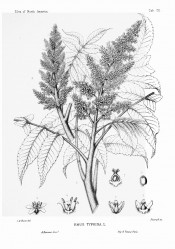Rhus typhina L.
Hardy, deciduous, dioecious, wide-spreading shrub or small tree, the young shoots covered in reddish-brown hairs, the leaves large, pinnate and turning yellow, orange, red or purple in autumn, with large, erect clusters of male flowers, the female flowers followed by hairy crimson fruit. To 6m or more. [RHSD, Hortus].
Horticultural & Botanical History
‘Rhus typhina grows in New Brunswick and extends westward through the valley of the St. Lawrence to southern Ontario and Minnesota, and southward through the northern states and along the Alleghany Mountains to northern Georgia and to central Alabama and Mississippi. It is a common plant in nearly every part of this region, although it is more generally distributed on the Atlantic seaboard than in the region west of the Alleghany Mountains. It usually grows on uplands in good soil, spreading into broad thickets to the exclusion of other plants, but is sometimes found on sterile gravelly banks and near the borders of streams and swamps.
The wood of Rhus typhina is light, brittle, soft, and coarse-grained, with a satiny surface that takes a good polish. Its layers of annual growth are clearly defined by four to six rows of large open ducts; it contains numerous obscure medullary rays and is orange-color streaked with green, with thick nearly white sapwood. It has been employed in inlaying furniture made of other woods, but probably is now little used. The specific gravity of the absolutely dry wood is 0.4357, a cubic foot weighing 27.15 pounds. From the young shoots of this tree pipes are made for drawing the sap of the Sugar Maple. The bark, especially of the root, as well as the leaves, is rich in tannin. An infusion made from the astringent and refrigerant fruit is occasionally employed as a gargle.
Rhus typhina was known to Europeans in the beginning of the seventeenth century. It was first described by Caspar Bauhin in 1623, and was cultivated in England by John Parkinson as early as 1629. The Staghorn Sumach is occasionally found in American gardens; and in central and northern Europe it is now one of the most common and popular exotic trees. It can be grown with a single stem for the decoration of the lawn, or it can be used with good effect to cover gravelly slopes, the margins of roads, and other waste places.
The excellent habit of the Staghorn Sumach, its ample and brilliantly colored foliage, its large panicles of male flowers, and its brilliant fruit make it one of the most beautiful of the small trees which inhabit the northern states.
The specific name, derived from [the greek, untranslated], relates to the supposed virtues of this plant in the treatment of fevers.’ [Sargent – Silva of North America vol.3, p.16, pl.102/1892].
Introduced to Britain before 1629. [JD]. The male tree has in the past been called Rhus viridiflora.
History at Camden Park
Rhus typhina is marked with a ‘c’ in an 1836 edition of Loddiges’ catalogue held at Camden Park [CPA]. In William Macarthur’s code, used and explained elsewhere, this means grown at Camden. It is almost certain that it was grown in the gardens around this time but it did not appear in the catalogues and may have been short-lived. Possibly introduced as much for its medicinal and industrial uses as for its undoubted ornament.
Notes
Published Apr 02, 2010 - 05:05 PM | Last updated Apr 02, 2010 - 05:13 PM
| Family | Anacardiaceae |
|---|---|
| Category | |
| Region of origin | Eastern North America |
| Synonyms |
|
| Common Name | Staghorn Sumach |
| Name in the Camden Park Record |
Rhus typhina |
| Confidence level | high |


